Qualitative Analysis of a Fractional Pandemic Spread Model of the Novel Coronavirus(COVID-19)
2021-12-14AliYousefFatmaBozkurtandThabetAbdeljawad
Ali Yousef,Fatma Bozkurt and Thabet Abdeljawad
1Department of Mathematics,Kuwait College of Science and Technology,27235,Kuwait
2Department of Mathematics,Erciyes University,Kayseri,38039,Turkey
3Department of Mathematics and General Sciences,Prince Sultan University,Riyadh,11586,Saudi Arabia
4Department of Medical Research,China Medical University,Taichung,40402,Taiwan
5Department of Computer Science and Information Engineering,Asia University,Taichung,Taiwan
Abstract:In this study,we classify the genera of COVID-19 and provide brief information about the root of the spread and the transmission from animal(natural host)to humans.We establish a model of fractional-order differential equations to discuss the spread of the infection from the natural host to the intermediate one,and from the intermediate one to the human host.At the same time,we focus on the potential spillover of bat-borne coronaviruses.We consider the local stability of the co-existing critical point of the model by using the Routh–Hurwitz Criteria.Moreover,we analyze the existence and uniqueness of the constructed initial value problem.We focus on the control parameters to decrease the outbreak from pandemic form to the epidemic by using both strong and weak Allee Effect at time t.Furthermore,the discretization process shows that the system undergoes Neimark–Sacker Bifurcation under specific conditions.Finally,we conduct a series of numerical simulations to enhance the theoretical findings.
Keywords:Allee Effect;coronavirus;fractional-order differential equations;local stability;Neimark–Sacker bifurcation
1 Introduction
In the last few months,nature has showed its laws in establishing the environment of the 21st century.It is out of our primary objective whether the coronavirus(COVID-19)is used as a biological weapon or not.The main point is now that humans are fighting against something to survive that has a genome size of 27 to 34 kilobases.Coronaviruses are members of the sub-family coronavirinae in the family coronaviridae and the order Nidovirales[1,2].They show four genera,which are given in Tab.1.
The natural host of SARS-CoV,MERS-CoV,HCoV-NL63,and HCoV-229e are bats,while HCoVOC43 and HKU1 have originated from rodents[3,4].In the spread of transmission,domestic animals have only intermediate host role from the natural host to the human one.Covid-19 was not considered as highly pathogenic,until the outbreak of SARS-CoV in 2002 and MERS-CoV in 2012.The spread of SARS-CoV in China(Guangdong)showed a COVID-19 that was transmitted from bats to an intermediate host,like market civets from which the transmission spreads to the human host.At the same time,the outbreak of MERS-CoV in the Middle East Countries also came from bats to dromedary camels as an intermediate host,and from the dromedary camels to humans[5–8].These viruses cause respiratory and intestinal infections,with symptoms including fever,dizziness,and cough.In December 2019,a novel Coronaviridae was reported in China(Wuhan).The outbreak was associated again with intermediate hosts like reptilians,while the natural host was assumed as bats.This virus was designated later as Covid-19 by the WHO.

Table 1:Genera of COVID-19 and the pathogenic class
Covid-19 was characterized by two members of β-coronavirus;the human-origin coronavirus(SARSCoV Tor2)and bat-origin coronavirus(bat-SL-CoVZC45).Intensive studies show that it was most closely related to the bat-origin coronavirus[9].Thus,the primary assumption formed was that the natural host of Covid-19 spreads by infected bats of genus Rhinolophus that are mainly in the area of Shatan River Valley.
Domestic animals,like snakes in that area,were hunted for the food market in Wuhan,which played an intermediate host role in the transmission.Finally,this virus spillover from the intermediate hosts to cause several diseases in human.A virus that started with an endemic pathogenic behavior in China(Wuhan)reaches somehow to a pandemic point worldwide with the infection from human-to-human.
2 The Model Description
It has been realized that the dynamics of many biological and medical phenomena can be characterized via mathematical models.Over the years,many models are formulated mathematically to analyze events in biological and medicine such as infections,treatments,or environmental phenomena[10–13].The study of these phenomena has been restricted to models of integer-order differential equations(IDEs).However,it is seen that many problems in biology,as well as in other fields like engineering,finance,and economics,can be successfully formulated by the so-called fractional-order differential equations(FDEs);see,for instance,the papers[14–20].The nonlocal property of models of FDEs is not only depending on the current state but also provides an adequate description for the historical ones.It is evidenced that FDEs can model certain phenomena that cannot be modeled by IDEs.Thus,FDEs are mainly used on biological models since they are relevant to systems with memory and hereditary[21–27].
In this paper,we establish a model that describes the pandemic infection,which occurs when the virus is transmitted from the human body to the intermediate host and continues to spread from human-to-human.The model consists of five fractional differential equations.The first three equations show an SI(susceptible-infected)model to explain the transmission from human-to-human,whereSis the susceptible class,C1is the infected type that does not know they are infected because of the late occurred symptoms of COVID-19 and C2shows the infected class that knows they are infected.The spillover from the intermediate infected classMto the human hostSdenotes a predator-prey mathematical model,while for the transmission from the natural hostN,which is the bat population,to intermediate hostMis a hostparasite model of Holling Type II.

Indeed,the mathematical model of this biological phenomena has the form:
where

represents the Holling type II function and all the parameters of the model(1)belong toand t ∈0,∞[).
The susceptibleSis composed of individuals that have not contacted the infection but can get infected through contacts from the human that does not know they are infected and from the intermediate hosts.The parameter r1is the population growth rate of the susceptible population and μ1denotes the logistic rate.pis a rate of the susceptible population per year.The susceptible lost their class following contacts with infectivesC1and the intermediate host M at a rate β1and β2,respectively.The parameter σ1links the parameter of the interaction between the huntedMclass and the predatorSpopulation.
TheC1class does not know that they have COVID-19.In this equation,r2is the population growth rate of the class,while μ2is the logistic rate.The population of this class decreases after screening at a rate θ and be aware of the infection.Another possibility is that after the S-C1contact,the symptoms occur in early stages so that both classes noticed that they are infected,which is given with the rate ε1.The intermediate host infected group could also show early symptoms to be aware of the infection,which is provided by a rate of ε2.The logistic rate of C2is denoted as μ3.
Mis the domestic animal as an intermediate class in the corona transmission spread.r3is the intrinsic growth rate of the population,while μ4is the logistic rate.σ2shows the effect on the hunted M during the interaction between the intermediate host and susceptible class.γ denotes the predation rate in the hostparasite scheme.
Nrepresents the natural host(bat population)of COVID-19 in this dynamic system.r4is the intrinsic growth rate and μ5is the logistic rate of the population.δ shows the conversion factor of the natural host.eis the attack rate of the bat population to infect the M,while ω(0 <ω ≤1)represents the fraction of the potential infectivity of the natural host.his the rate of average time spend on infecting the domestic intermediate class,which is also known as the handling time.
Tab.2 shows description of the parameters that are given in system(1).

Table 2:Description of the parameters

Table 2(continued).ParameterSymbol rate Logistic rate of C2 t( )μ30.15 Logistic rate of M t( )μ40.01 Logistic rate of N t( )μ50.01 Rate of the S t( )population per yearp1.6 Parametric lost from class S t( )to C1 t( )β1,β2 0.00134,0.00044 Rate of interaction between S t( )-M t( )σ1,σ2 0.0001 Predation rateγ0.0044 Rate of screeningθ[0.01,0.05]Recognition of infectionε1,ε2[0.1,0.4]A conversion factor of N t( )δ0.0045 The attack rate of N t( )to M t( )e0.15 Rate of average time on infecting M t( ) h0.15 Potential infectivity of N t( )ωω ∈ 0,1( ]
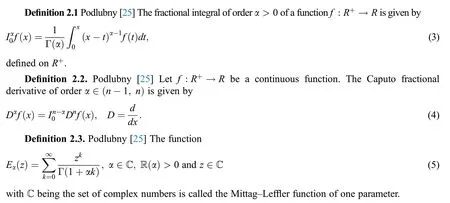
3 Stability Analysis of the Co-Existing Critical Point



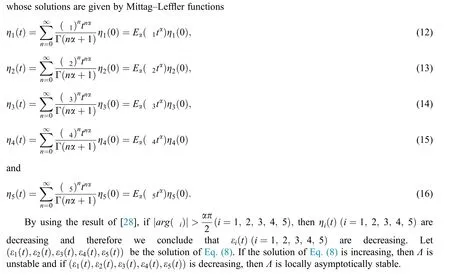
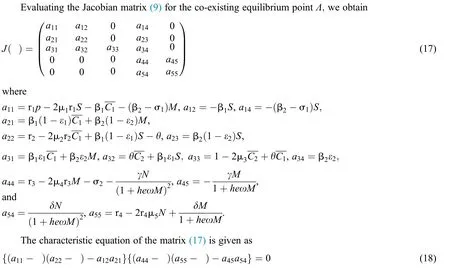


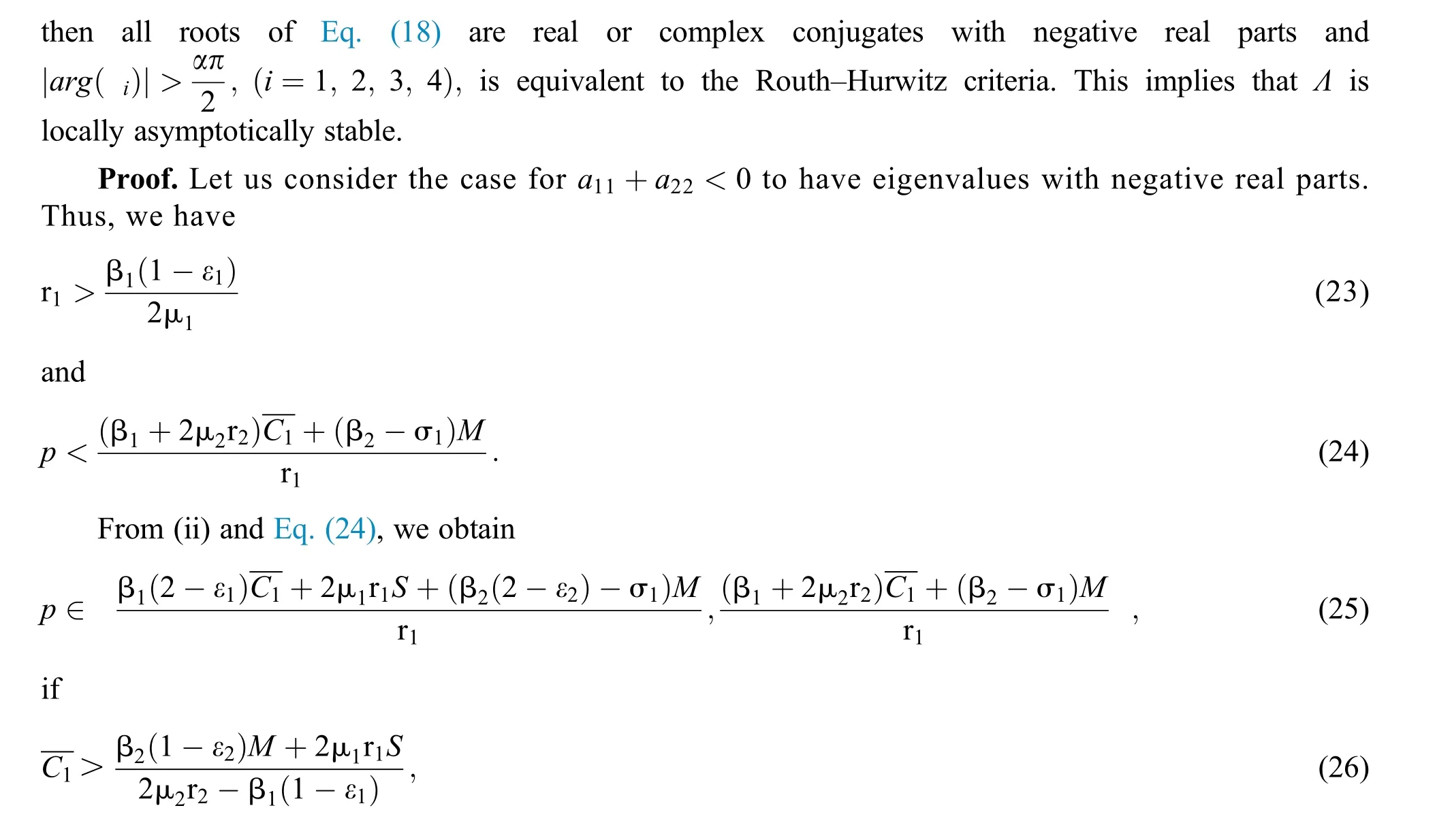








Example.In this part,we present numerical simulations that are in good agreement with our theoretical results.We assume the initial conditions of the system(1)asS(0)=1000,C1(0)=80,C2(0)=40,M(0)=30 andN(0)=10.
In Fig.1 the blue graph denotes the susceptible classSand the red graph showsC1who does not know they are infected.Fig.1 represents the transmission of the infection that occurs as an epidemic case in some areas,but it spreads intensively to a pandemic case and covers almost the susceptible class.Here we want to emphasize the point of screening,where we assume that about %1 do testing in the hospitals before the symptoms appear.Additionally,we consider that the symptoms appear late,and thus the awareness of the infection is also at %1.This changes the endemic spread from epidemic to an uncontrolled pandemic form.

Figure 1:Spread of the C1 class and effect on the susceptible S class,where θ=0.01 and ε1 = ε2 =0.1
In Fig.2,we keep the screening parameter as θ=0.01,while we consider the case that the people become aware of the virus and the symptoms of it through media and health organizations.An organized and constant information flood from media might increase the awareness up to ε1= ε2=0.4.

Figure 2:Spread of the C1 class and effect on the susceptible S class,where θ=0.01 and ε1 =ε2 =0.4
This awareness of the people through media and health organizations let them go to hospitals for screening so that the class who does not know they are infected decreases.Fig.3 shows the effect of the testing when it reaches to%5.The spread is under control and returns to an epidemic form.

Figure 3:Spread of the C1 class and effect on the susceptible S class,where θ=0.05 and ε1 =ε2 =0.4
We considered in these examples the infection from human-to-human since the pandemic case reaches from the human transmission.We want to emphasize the strong coordination between health organizations and the media which is an essential tool for two critical parameters,which are θ and εi(i=1,2)
The design of nature keeps the natural host and intermediate host in a stable dynamical system in the habitat.The intermediate host had only a transmission role from animal to human,while the main spread happens through human to human from theC1class who does not know they are infected.
4 Existence and Uniqueness of the Initial Value Fractional-Order Problem




5 The Case of Extinction via Strong Allee Effect


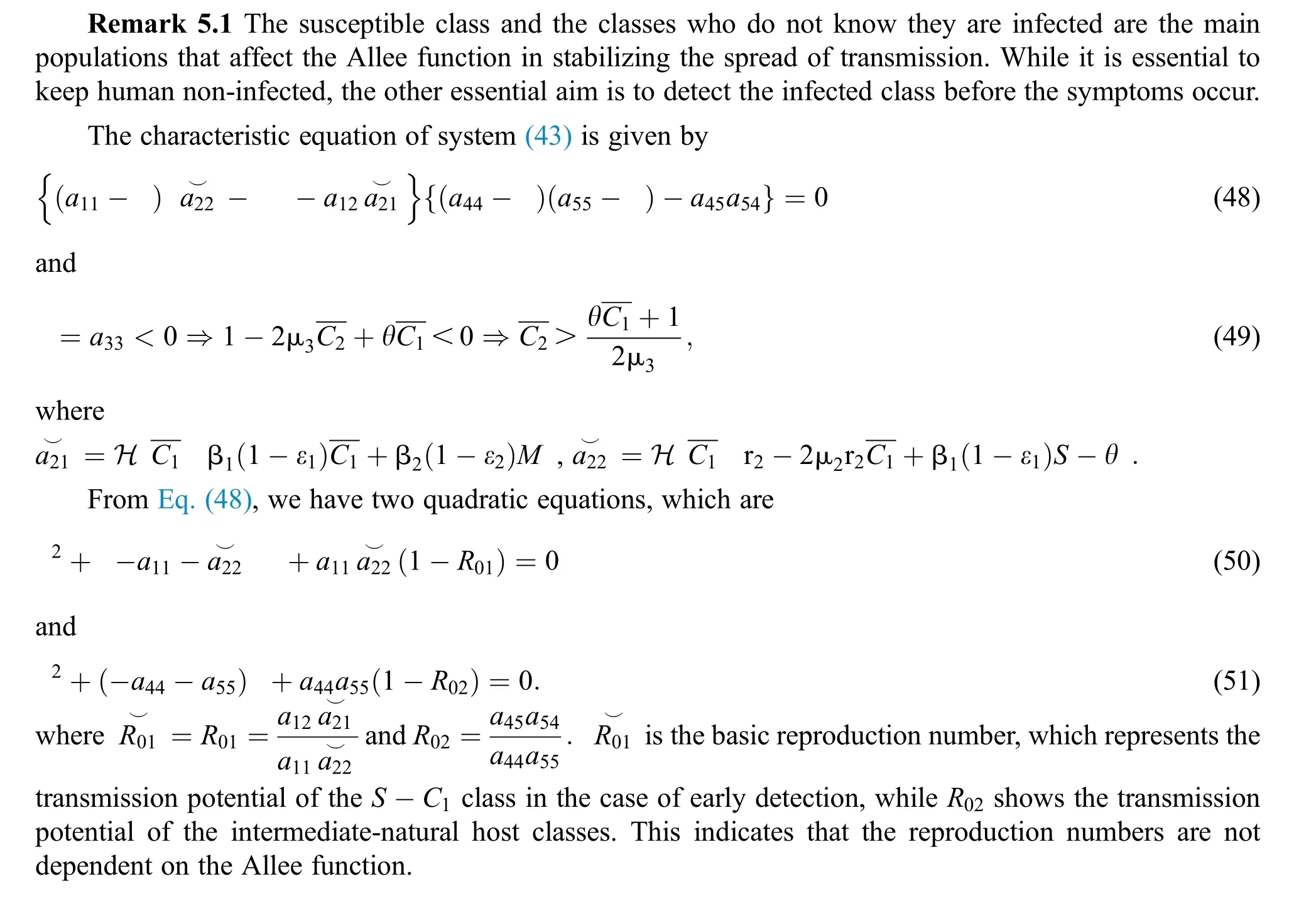





6 Neimark–Sacker Bifurcation of the Dynamical Behavior with Discretization










7 Conclusion
In this paper,we classified the coronaviruses and their spread from the natural host to the human host.We proposed a model of the novel coronavirus,which is known as COVID-19,as a system of fractionalorder differential equations.We divided the system into five sub-classes:
the susceptible classS,the infected classC1,that does not know they are infected since specific symptoms did not appear,
the infected classC2that knows they are infected because of some symptoms such as respiratory and intestinal infections,including fever,dizziness,and cough,appeared.
the intermediate domestic hostM,that has a transmission role from the natural host to the human host the natural hostN,that are bats of genusRhinolophus.
We consider the pandemic infection case;animal to human and human to human.Therefore,the first three equations in the constructed model show human to human transmission.The spillover from the intermediate infected class to the human host denotes a predator-prey mathematical model,and the transmission from the natural host to intermediate hostMis a host-parasite model of Holling Type II.
In Sections 3 and 4,we analyzed the local stability of the co-existing equilibrium point by using the Routh–Hurwitz Criteria.We proved the existence and the uniqueness of the initial value problem.
Theorem 3.1.,shows that among the human hosts,those who do not know they are infected are the control class in the spread.While between the animal hosts,the intermediate class plays a dominant role in the spread since that class has an essential role in transmitting the virus from animal to human.The transmission potential for bothS-C1andM-NisR01<1 andR02<1,respectively.Also,the susceptible class and theC1class is stable based on two parameters,which is the awareness of the symptoms and the screening rate.
In Theorem 3.2.,we emphasized thatC1class should be more aware of the symptoms that might become from the susceptible class as well as from the intermediate class,than theSclass to stop the outbreak.For the susceptible class,it is more important to keep the population rate per year non-infected.The transmission of the virus to the offspring would reach an uncontrollable phenomenon worldwide.
In Section 5,we incorporate the Allee function at timet.The strong Allee effect is analyzed so that the screening for possible inflectional cases is an essential control parameter to support the Allee function in stabilizing the effect of the spread.
In Section 6,we deduced that the system demonstrates a Neimark–Sacker bifurcation under specific conditions.
Availability of Data and Material:All data generated or analyzed during this study are included in this published article.
Authors’Contributions:Yousef and Bozkurt conceived the study and was in charge of overall direction and planning.Bozkurt and Yousef designed the mathematical model and set up the main parts of the study.They proved the theorems.Bozkurt,Yousef,and Abdeljawad collected the data and analyzed them.All authors interpreted the data and carried out this implementation.Bozkurt and Yousef conducted the simulation results using MATLAB 2019.All the authors are involved in writing and editing the manuscript.There is no Ghost-writing.
Acknowledgement:F.B.acknowledges the support of Erciyes University for the research study.
Funding Statement:The author(s)received no specific funding for this study.
Con ict of Interest:The authors declare that they have no conflicts of interest to report regarding the present study.
杂志排行
Computers Materials&Continua的其它文章
- Design of Authoring Tool for Static and Dynamic Projection Mapping
- Detecting Lumbar Implant and Diagnosing Scoliosis from Vietnamese X-Ray Imaging Using the Pre-Trained API Models and Transfer Learning
- Design of a Compact Monopole Antenna for UWB Applications
- A Smart Wellness Service Platform and Its Practical Implementation
- Fingerprint-Based Millimeter-Wave Beam Selection for Interference Mitigation in Beamspace Multi-User MIMO Communications
- Multilayer Self-Defense System to Protect Enterprise Cloud
